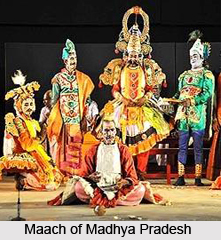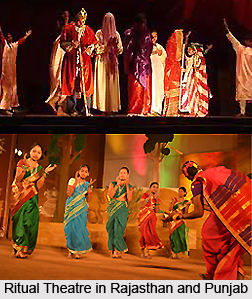 Ritual Theatre in India, mainly based on oral traditions, forms the second phase of evolution of theatre in the country. It was performed for the first time around 1000 AD onwards and continued up to 1700 AD and is still performed in some parts of India. The coming together of this form of theatre can be attributed to the existence of various types of regional languages in India. Unlike the classical theatre, which was sophisticated and urban oriented - due to its connection with Natyashastra, the traditional theatres in India emerged from rural roots, and was naive, simple and closer to rural milieu.
Ritual Theatre in India, mainly based on oral traditions, forms the second phase of evolution of theatre in the country. It was performed for the first time around 1000 AD onwards and continued up to 1700 AD and is still performed in some parts of India. The coming together of this form of theatre can be attributed to the existence of various types of regional languages in India. Unlike the classical theatre, which was sophisticated and urban oriented - due to its connection with Natyashastra, the traditional theatres in India emerged from rural roots, and was naive, simple and closer to rural milieu.
Origin of Ritual Theatre in India
Folk theatre in India, which can be broadly divided into two parts - secular and religious- is deeply embedded in ritual. It was a characteristic collectivist activity generated by religion and faith. Most of the folk theatres are vocal or narrative, i.e. recitation and singing based on Ramlila, Raslila, Nautanki, Wang and Bhand, without any intricate elements and gestures or movements of dance. India is also known for rich ballad singing traditions like "Pabuji-ki-phar" of Rajasthan and "Nupipaala" of Manipur. These theatrical styles have their own local customs, but they differ from one another in staging, custom, make up, execution and acting style. South Indians emphasize more on dance through Kathakali and Krishnattam of Kerala, but North Indian lays focus on songs, like Maach of Madhya Pradesh, Khyal of Rajasthan and Swang of Punja, while the Jatra of West Bengal and Bhavai of Gujarat stress upon dialogues and its execution. Societal ties with ancestral spirits or supernatural forces are institutionalized in procedures of repetitive action believed to be efficacious. Blessings of deities are sought, that the community is protected from sickness, calamity or death. The living possessions in domestic animals do not fall prey to disease or epidemic. Plentiful harvests or bountiful rains follow, and that harmony with nature prevail. Mourners undergoing social oblivion in mortuary rites become reinstated to communal equilibrium through rites of passage. When people searched for association with the divine, special mediums developed professionally to facilitate the relationship. Their intense practices imbibed non-corporeal, spiritual faculties or characters to help ease the subjects` transcendence. These phenomena were possible only through ritual.
 Belief of Ritual Theatre in India
Belief of Ritual Theatre in India
Cyclical community performances incorporating dance, music, formalized movement, feasts, appeasement of malignant spirits, offerings of food, vegetables, fruits, flowers or aromas, processional and celebratory events, pervade ancient agricultural civilizations. Ritualistic life brought order and sanity to an otherwise relentless world habitually engaged with insecurity and survival. The religious and intellectual elite developed deep philosophies to sustain the world view, manifested by the masses in physical enactment of the cosmic order. Subterranean forces were eased by the repeated action and routine of ritual participants in free and creative abandon, giving them the self-belief necessary to face oncoming disasters or danger. Ritual, therefore, was not simply a culture of primitive, non-rationalist, pre-modern societies. Highly advanced spirituality, non-materialism, and universality of thought and wisdom were associated with it.
Indian theatre automatically reflected such attitudes, though such ancient proto-theatre as the Manipuri Lai Haraoba epitomizes ritual performance. Both classical and popular forms presented stories of ancestral heroes, narratives of mythic lore and legends as communicative acts to link the mundane with the world of Special Forces. In theory, the whole production formed a ritual, founded on the Hindu philosophical premise that life is Lila, a divine play. In addition, Sanskrit theatre specified elaborate preliminaries or purvaranga that connected the performance with an act of worship. The citizens were disciplined through the enactment of familiar movements and procedures, volitional acts, mantras, and chants that could effect beneficial changes in the course of nature. Even now, the sutradhara explicitly voices a benedictory nandi to invoke blessings of gods and goddesses. To this day, an urban performer may ritualistically touch the stage floor before entry as a symbolic act of personal faith and to elicit good fortune.
Use of Ritual Theatre in India by Contemporary Artists
Efforts by contemporary Indian artists to use aspects of ritual were noticed mainly in Kerala, Tamil Nadu, Karnataka, and Manipur. In those places ancient theatrical ritual remained strongly embedded in tradition. Western practitioners, confronting trouble of lost community severed by secularism, industrialization, and capitalism, produced new social ceremonials innovatively bringing spectators into a rediscovery of the modern community. On the other hand, Indian directors vibrantly explored the living nuances of an ongoing culture, creating imagery and patterns evoking subtle effects and aesthetic novelties based on previously undiscovered motifs. But this helps to reinforce conventional spiritual expressions. The world of ritual in theatre and theatre in ritual has substantive potential for deeper insights into human communication and exchange.




